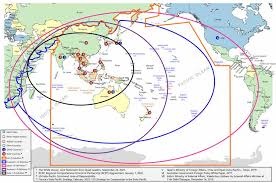China’s rise in Indo-Pacific region poses challenges to others
Shahriar Nehal । Source: Daily Observer, 4 January 2025

The geopolitical fabric of the Indo-Pacific region has, by and large, changed due to the emergence of China as a major global power. Bordered by rapid economic growth, Beijing has also witnessed massive military advancements; bold strategies have been adopted in consolidating its influence and challenging the status quo in the regional power architecture. The major consequence, then, rests on the neighboring countries, shaking the stability of the region and affecting the wider international community.
The Belt and Road Initiative (BRI) is at the forefront of China's Indo-Pacific agenda, which is a world-spanning infrastructure development program for various continents. This BRI by China seeks to increase economic partnerships, enhance connectivity, and improve political leverage throughout the regional matrix. Although it has been touted for growing economies and facilitating trade, it has drawn criticism from countries claiming it would put their economies into unsustainable debt. According to many, the BRI serves China, through development assistance, as another major geopolitical tool to extend its influence.
Military modernization comprises one pillar of the approach China intends to take in the Indo-Pacific region. The People's Liberation Army (PLA) has undergone radical changes and refurbishments, with an emphasis on building naval and air power; all designed to project the reach of Beijing far beyond its borders. Such a buildup, however, alarms neighboring nations and other regional powers over China's activities in contested areas like the South China Sea.
Currently, the South China Sea is emerging as a regional hotspot following Beijing's extensive claims over waters that encompass almost the entire area. Accompanied by extensive reclamation activities, artificial islands are being militarized, and increasingly aggressive actions are now being observed in these areas. Affected countries have raised objections against such intrusions, which concern more than just the traditional issues of territoriality-driving some of the world's most vital maritime trade routes towards freedom of navigation. The situation also reduces the sovereignty of neighboring states in the region under the broader challenge of an increasingly contested principle of open seas.
Likewise, the Senkaku Islands (known as the Diaoyu Islands in China) have been claimed by China in the East China Sea, causing tension between China and Japan. The two countries have increased military activities in the area. Both nations frequently send their forces to the airspace or waters of the area, escalating the recent tensions. Such actions carry significant potential for accidental escalation, reflecting an unstable balance of power in the region and complicating the broader picture of regional stability in terms of its larger implications.
Regional powers respond to China's increasing assertiveness by strengthening their strategic alliances. The most prominent coalition thus far is the Quadrilateral Security Dialogue (Quad), composed of the United States, Japan, India, and Australia. The Quad seeks a vision of a free, open, and inclusive IndoPacific, contrasting with China's perspective on the region. Through joint military exercises, economic cooperation, and diplomatic engagement, the Quad has rapidly established itself as a major counterbalance to Beijing's ambitions.
Currently, the South China Sea is emerging as a regional hotspot following Beijing's extensive claims over waters that encompass almost the entire area. Accompanied by extensive reclamation activities, artificial islands are being militarized, and increasingly aggressive actions are now being observed in these areas. Affected countries have raised objections against such intrusions, which concern more than just the traditional issues of territoriality-driving some of the world's most vital maritime trade routes towards freedom of navigation. The situation also reduces the sovereignty of neighboring states in the region under the broader challenge of an increasingly contested principle of open seas.
An aspect of the concern regarding the strategy of building China's economic dependence among small countries in the Indo-Pacific lies in the investments and economic ties China has established in places like Cambodia, Laos, and Sri Lanka. By and large, China's economic influence has translated into intra-political alignment with Beijing, raising questions about the sovereignty and decision-making freedom of these nations. Critics argue that it creates power asymmetries in the region, potentially leading to increased dependency on China.
However, careful navigation will be required by the international community to manage the complexities of China's strategic ambitions. A balance-between competition and cooperation-is essential for stability and prosperity in the region. Through multilateral forums, diplomacy, and confidence-building measures, disputes can be resolved, and dialogue can be fostered among key stakeholders. The main pillar of these efforts is the commitment to international norms and the continued advocacy for rules-based orders.
In its proactive phase toward achieving its strategic goals, China currently stands at a significant advantage in the Indo-Pacific. The strategic decisions and actions taken in this region by China, the regional powers, and the global community in the coming years will shape its future trajectory:
Will this become an arena of increasingly intense rivalry and heightened geopolitical competition, or will it evolve into a zone of shared growth and collaboration?
The answer to this question will determine the survival strategies of nations that rely on pragmatic diplomacy and strategic foresight. Regional stability will be achieved through open channels of communication, established economic dependencies, and the peaceful resolution of security issues. As we absorb more globalized external influences into sustainable mainstream cooperative interests and face mutual challenges, the Indo-Pacific threat manifests traits of progress, though not easily achieved, in an increasingly connected world moving toward a model of coexistence and mutual benefit.
The Indo-Pacific serves not only as a stage for great power competition but, crucially, as a platform for regional and global cooperation. Whether it becomes a theater of war or a zone of prosperity depends on the collective will and wisdom of nations. The complexity of an evolving landscape such as this underscores the importance of diplomacy and dialogue, as well as a commitment to the principles of a rules-based international order.